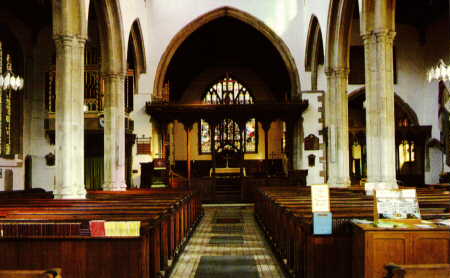

Mid-fourteenth century: the cross-wall either side of the chancel arch is the oldest part of the whole church. In the 15th century the Decorated capitals and arch were removed and the North turret-stair built to the rood loft, a railed platform across the church where the top of the present screen reaches: here the Holy Communion gospel was read on festal days. Its bricked-up doorway is high up in the N.E. corner of the Nave. About the same period the two side-chapels were added. An interim classical screen and musicians' gallery appear in a pencil sketch by Constable on the South Aisle wall. The present chancel woodwork was designed by Sir T.G. Jackson.
In the North wall is an Easter Sepulchre recess depicting the Resurrection of our Lord, with leaf decoration in a beautiful freehand arabesque pattern of the mid-15th century. In it were laid the consecrated bread from the Maundy Thursday Holy Communion, and the Altar Cross-head on Good Friday, in token of His Burial, to be carried in procession to the altar on Easter morning in honour of His Resurrection.
Beside it, a memorial to Maria, wife of John Constable; opposite, a fine alabaster acrostic monument with two well-carved angels.
From the Crossing can best be seen the West window by Mr Hugh Arnold (with the blue lion of Emmanuel College, Cambridge, the present patrons), and the "Good Shepherd" memorial to a beloved Rector.
Now the clergy vestry and organ chamber. Outline of a Consecration Cross on its South wall: others are on the North walls of the Chancel and South Chapel.
The organ was purchased in 1963 from St. Andrews, Gravesend where a new church warranted a new instrument. It was completely rebuilt - at ten times the purchase price of £250! - by Bishops of Ipswich and is generally considered to be in the 'top twenty' in Suffolk. For the technically minded there are two manuals with pedal board and, including the original trumpet which had been held in store until fitted in 1985, 25 speaking stops.
Fragments of the tomb of Anna Parker, died 1656, show a bear's head and camels. Next, on a plain stone, the oldest inscription, possibly of the 15th century: What ere thou art here reader see, in this pale glass what thou shalt be, despised wormes and putrid slime, then dvst forgot and lost in time - etc. The memorial to John Mattinson reads: Eleven years the beloved schoolmaster of this Town, and then unfortunately shott. The Latin couplet means He profited and pleased, mixed business with pleasure, to his pupils a terror and a delight.
Parish chest dated by the horned lock-plate about 1400 A.D.; the lid is a hollowed-out tree trunk, probably of poplar.
Brass (the only one apart from empty "matrices") to Robert Alefounder, died 1639.
From the centre aisle can best be appreciated the two hundred or so colourful pew kneelers made by many village ladies over the last 15 years.
A very fine oak screen, with carving typical of Suffolk. A pleasing series of "Works of Christian Mercy" windows.
The World War 1 memorial has a good bronze of St. George and the Dragon. Centre window to John Constable, R.A., died 1837, the local born artist, with his sketch of the Chancel and Sanctuary in his time, and an engraving of Willie Lotts cottage at Flatford on the Stour. Note the undated but probably Victorian sketch of a possible tower - the implication being that completion of the tower was still being contemplated 300 years after Wolsey's death.
After 15 years 'on the drawing board' the re-development of the West End took place in 1991. The font - which stood in the middle of what is now the Meeting Room - was moved to its position near the South Door and four short pews were removed. Two choir vestries had been built in 1958; the one on the North side has become a 'unisex' vestry for all the choir while the other has been incorporated into the scheme.
With some thought going into furnishings, heating independent of the main church system, and a fair degree of sound-proofing we now have an area capable of seating 60 but which can be used, for example, for Sunday School classes concurrent with a service. Conversely the provision of three pairs of double doors means that the area can be opened up and used for additional seating at major services.
If you have enjoyed reading and seeing our great church, please say a prayer for those who minister and those who worship here, and for the work for which it stands. God bless you.
| Home | © Copyright |